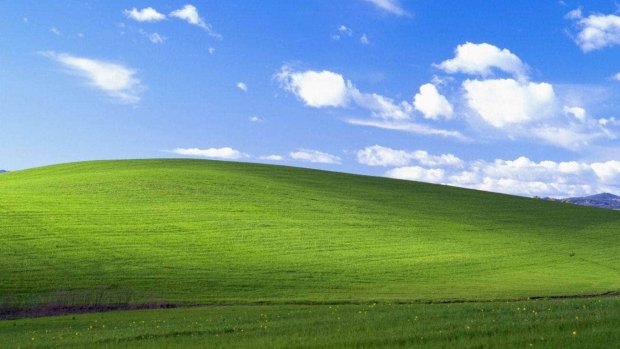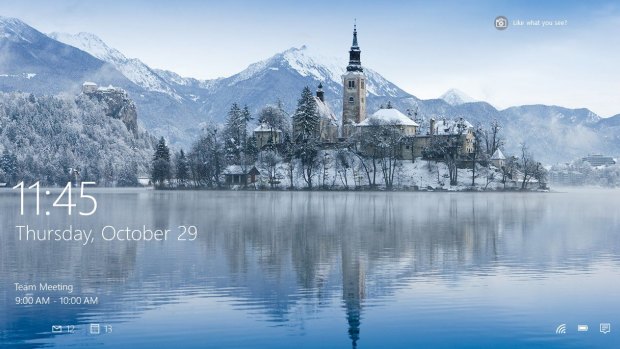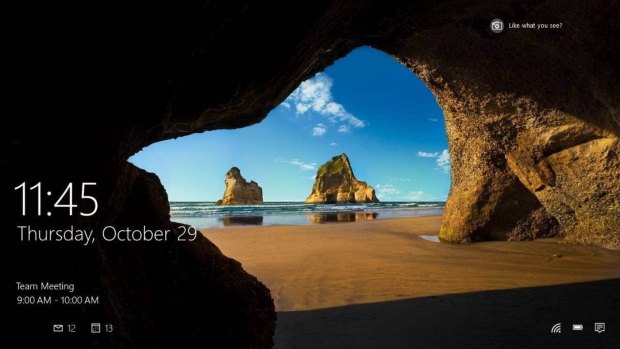This was published 3 years ago
The locations behind the screensavers on Apple and Microsoft: How this became the most-viewed photograph of all time
By Ryan Bacic

Look familiar? Charles O'Rear's Californian hillside was beamed onto millions of computer screens in 2001.Credit: Charles O'Rear/Microsoft
Chuck O'Rear was driving through California wine country to visit his girlfriend, as he did every Friday, and scanning for possible pictures for his stock-photo service, as always. "We just never know," he and his business partner figured, and so O'Rear's camera went with him.
At some point on that trip in January 1996, O'Rear was struck by the scene of a rolling green hill and stopped the car. He snapped a shot. "Yeah, OK. That's an OK picture," he remembers thinking.
That "OK picture" went on to be acquired by Microsoft, named "Bliss" and beamed onto millions of computer screens in 2001, as the default background image for Windows XP. It is now, by a number of outlets' guesstimates, the most-viewed photograph of all time.
"It's got to be over a billion people who have seen it," O'Rear, now retired and living in North Carolina, said on a recent phone call. "I've seen it on ferryboats in Greece. I've seen it at hotels in Thailand. It's just something that we lived with."
As "Bliss" nears the 20-year anniversary of its burst to fame, trapped remote workers are living with their screen images perhaps more than ever. And with travel still restricted, staring at that rolling green hill on your computer, or that mountain-nestled Austrian village on your TV, is as close to seeing the world as most of us will get.
It's part of 2020's odd, new reality, and the people choosing those screen images recognise it. So, whether you've noticed or not, they have been adapting their words and visuals alike.
"Right as covid was starting, we made sure we took down anything that talked about explicitly travelling," said Matt Hepler, Microsoft's director of product marketing. ". . . We had to think about social distancing, and so we kind of have limited images that have groups of people together where they don't feel socially distanced. It wouldn't feel how the world is living today."
Hepler's team chooses images as a group, he said, and any negative visceral reactions in the room get a photo axed. Finding inspiration on Instagram, in National Geographic and in everyday life, Windows employees try "to keep it fresh" with varying desktop themes: Africa, Latin America, islands, Pride, photographs in black and white.
When Windows 10 launched, Hepler said, its lock screens had the images but didn't give locations. The biggest feedback they heard from users was: "We love your photos. Where are they?"

Credit: Microsoft
Some smart TVs and other devices have the same issue, prompting a slew of queries on Reddit and elsewhere about where, exactly, people's screen images are from. Apple computers, meanwhile, list locations for many wallpapers but also include generic descriptors (such as "Desert"). (Apple representatives did not respond to requests for comment.)
Windows's strategy may go the furthest. In response to that user feedback, Hepler's team started including on its lock screens, overlaid on its photographs, a teaser box of information on each location. If clicked, that "info tile" will send users to a Bing search upon logging in.
"I'll do that. I'll click on it, like, 'Oh, this is amazing,' " said Camille Johnson Taylor, executive director of tourism for Kane County in Utah. "I haven't really started to accumulate a list or anything like that, but I'm just more intrigued than I've ever been."
The region Taylor oversees has long drawn computer users' intrigue itself. The Wave, a rock formation in the Antelope Canyon, gained wider recognition as a Windows 7 wallpaper, and varying shots of Lake Powell, a vacation spot along the Arizona-Utah border, have graced Mac and Windows screens alike.
Sussing out the precise impact of screen images on a location's exposure and tourism is difficult. Asked about possible boosts from Mac computers' featuring of the "Blue Pond" in Hokkaido, Japan, Kay Allen, deputy manager of Japan's national tourism office in Los Angeles, called it "a little impossible to pinpoint."
But at least one travel destination attests to an observable bump.
The use of an image of the Moraca Canyon for Windows 10 was "huge marketing for Montenegro as a tourist destination," said Nina Vukčević, of the Balkan country's national tourism organisation. At least one famous tourist appears to have visited as a result: Microsoft co-founder Bill Gates, Vukčević said, came last year. He went zip-lining.
Sometimes a destination's screen status can even provide useful landmarks for other tourism spots nearby. That has been the impact of one Windows 10 image of a cave on New Zealand's Wharariki Beach, located at the northern tip of the country's main southern island.

Credit: Microsoft
"When people query where [our campgrounds] are, I ask them have they seen the start-up picture on Windows 10 of a beach . . . yes . . . well that is the beach [a 20-minute] walk from our park," wrote Glenda Kyle, the off-site booking and office manager for Wharariki Beach Holiday Park.
Part of why the shot of Wharariki Beach is so ubiquitous - and not just to locals - is that it ships with Windows 10 as the default first lock screen, Hepler said. Which means, in a sense, it's a direct successor to O'Rear's "Bliss."
For years, O'Rear said, people would contact him trying to find out where the California hill was. Some sleuths, he saw online, went so far as to deduce and post its coordinates.
But for those who may want to see their screen images in live form, the search for "Bliss" offers a warning: Even in non-pandemic times, the landscape can change quickly.
So to speak.
The California hill "changed from the time I took it, probably within a couple of years," O'Rear said. "It became a vineyard! So it didn't look the same anymore. It must have been a disappointment to a lot of people."
Hey: In 2020, we're used to disappointment.
And we're used to the images on our screens, too. To would-be travellers right now, that canyon photo might be a bit taunting. Looking at that beach cave isn't enough.
But maybe it's something.
"I'm really hopeful that we are able to bring a little bit of joy to people, a little bit of a window to the outside world," Hepler said. ". . . That type of sentiment would feel really good to us."
The Washington Post
See also: 49 countries in six years: Aussie photographer reveals most beautiful places on Earth
Sign up for the Traveller newsletter
The latest travel news, tips and inspiration delivered to your inbox. Sign up now.